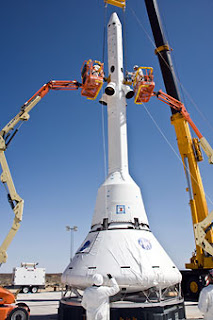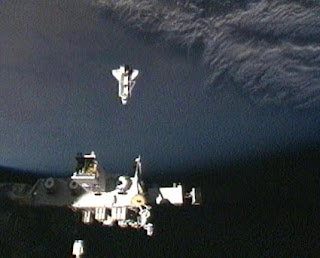
Capsule and Escape Tower Launch Prep
(credit US Army)
Yesterday NASA and the US Army conducted a nearly faultless test of the new Constellation Escape Tower system. Launched from the White Sands testing facility, the Tower lifted the capsule replica nearly a mile high and over a mile downrange. The motors actually were a bit more powerful than some of the testers expected, reaching a 16-G acceleration (they want to eventually get it down to 10Gs- a bit more survivable).
Tower maneuvers capsule at apogee.
The project has cost $220 million so far. One wonders how something like this could cost so much, but actually it's quite reasonable when you compare it to developing a new jet ejection system from nearly scratch which absolutely CANNOT be allowed to fail.
The funny part is, the program it's designed for has been cancelled by the White House. The continuing fight between some of Congress, some Constellation supporters, and the President's supporters seems resolved but awaits Congress' fight in the budget domain. What is clear is that according to law passed by Congress, the COnstellation program keeps testing for a year from cancellation. So the tests go on.
A few observations:
1) This tower system was supposed to save the Orion capsule in case of danger during launch; however, Orion has now been downgraded from a crew vehicle to an escape pod for the ISS (if it actually gets built). So the tower will never but used with Orion - the astronauts are not expected to launch up to the ISS in the darn thing.
2) This shows there was still good progress being made on the Constellation programs despite the denials of the Obama plan supporters. However, the cost overrun combined with the lack of sufficient funding from Congress doomed the project in the eyes of the Obama team.
3) This was a very necessary test program anyway- the results learned here will help private industry prepare the escape towers necessary for the devlopement of new crew-capable capsules for SpaceX, Boeing, or whoever DOES build the crew transfer vehicle.
4) The news media and NASA still refer to Orion as the Crew Exploration Vehicle, and refer to it as though it is still being developed for its original intentions. Haven't they been paying attention? There ain't gonna be NO exploring with this capsule, friends-- no crew will ride the capsule to orbit, and if they ride it down to Earth it's because of a major problem with the ISS.
Hoping for better planning...


























